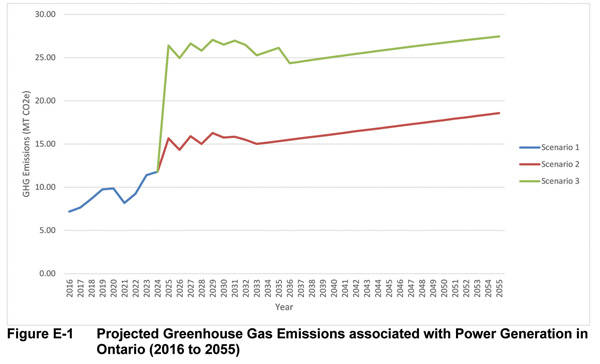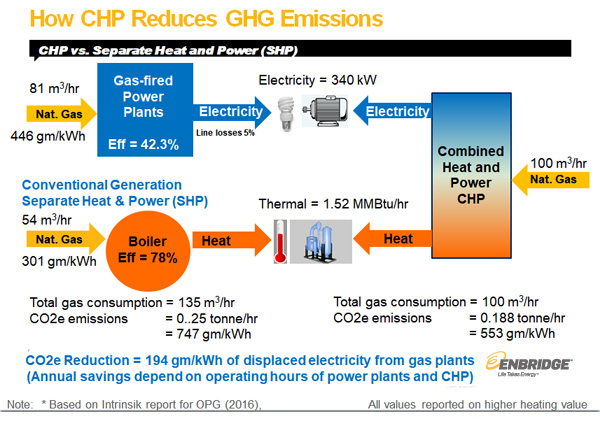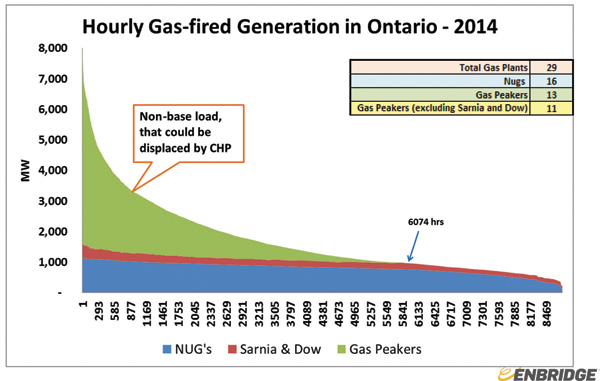Increasing the number and total capacity of efficient Combined Heat and Power installations in Ontario would result in a reduction of Ontario’s total greenhouse gas emissions, and it would be sound public policy to devise an emissions credit for the companies that install it. These are the key suggestions being put forward by the national non-profit organization QUEST (Quality Urban Energy Systems for Tomorrow) and Enbridge.
A report last October by consulting firm Intrinsik for Ontario Power Generation compared projected greenhouse gas (GHG) emissions associated with various methods of energy production in Ontario over the next 40 years, under various scenarios – mostly related to the shutdown of the Pickering nuclear generating station, and what might be done with the Darlington NGS. The study focused only on the estimated GHG emissions released to the Ontario environment as a result of the operations and maintenance of the facilities, not a life cycle assessment including their construction and disposal. In general, the conclusion is that, notwithstanding any increase in generation from renewable sources (principally wind, solar and water power), the province’s GHG emissions can be expected to increase sharply as natural gas will be increasingly relied on to fill the gap left by the loss of nuclear capacity. As a reliable, dispatchable energy source, natural gas is the resource that the Ontario system relies on to fill in between baseload nuclear, baseload/dispatchable hydro, variable wind and solar, and demand.
The Intrinsik report lists 8907.65 MW of gas-fired capacity installed in Ontario, as of last October. Of that, 1746.75 MW are cogen/CHP in 23 installations, all but four of them under 100 MW (one as small as 0.2 MW). Another 1203.2 MW are listed as under development, of which 14.2 are cogen/CHP. (Intrinsik uses both terms; the distinction seems to be merely a matter of the terminological legacy under which the plants were registered, rather than any technical difference.)
 As the Pickering nuclear station is shut down (scenario 2, red line), and potentially also Darlington (scenario 3, green line), Ontario’s greenhouse gas emissions climb from the increased use of gas-fired generation to fill the gap. Credit: Intrinsik
The argument being made by Enbridge and QUEST is that, instead of operating the existing less-efficient single-purpose gas-fired plants or building large gas-fired facilities to generate only the power needed to make up the difference when Pickering, and down the road potentially Darlington (scenario three in the graph), are shut down, the province could improve overall energy efficiency and reduce GHG emissions by encouraging more CHP. The missing ingredient in the formula would be an emissions credit for GHG reductions, applied to new CHP, as a reflection of its increased overall efficiency. Typical efficiency of a CHP plant is 78% versus 50%, a commonly-accepted figure for combined cycle, the most common type of gas-fired power generation technology.
As the Pickering nuclear station is shut down (scenario 2, red line), and potentially also Darlington (scenario 3, green line), Ontario’s greenhouse gas emissions climb from the increased use of gas-fired generation to fill the gap. Credit: Intrinsik
The argument being made by Enbridge and QUEST is that, instead of operating the existing less-efficient single-purpose gas-fired plants or building large gas-fired facilities to generate only the power needed to make up the difference when Pickering, and down the road potentially Darlington (scenario three in the graph), are shut down, the province could improve overall energy efficiency and reduce GHG emissions by encouraging more CHP. The missing ingredient in the formula would be an emissions credit for GHG reductions, applied to new CHP, as a reflection of its increased overall efficiency. Typical efficiency of a CHP plant is 78% versus 50%, a commonly-accepted figure for combined cycle, the most common type of gas-fired power generation technology.
 Credit: Aqeel Zaidi / QUEST
A good number of commercial and industrial (C&I) operations in Ontario have already installed cogeneration behind the meter in their facilities. These are typically sized, and operated, in order to supply the typical heat load for their operation – process heat used in manufacturing their product, and/or at least for space heat and hot water. The additional electricity thus generated also powers their operations, with possible export of any surplus to the grid, with energy and cost savings to all. It’s been encouraged over the past couple of decades by several programs to incent CHP, currently behind the meter CHP under the Conservation and Demand Program. The argument is that under Ontario’s new GHG reduction strategy, any operations manager considering installing new CHP has to consider the additional cost of the increased fuel use, including the carbon fee, which is applied like a tax on the fuel. If that additional cost was offset by a credit, recognizing the overall systemic GHG reduction, it would remove that disincentive.
Credit: Aqeel Zaidi / QUEST
A good number of commercial and industrial (C&I) operations in Ontario have already installed cogeneration behind the meter in their facilities. These are typically sized, and operated, in order to supply the typical heat load for their operation – process heat used in manufacturing their product, and/or at least for space heat and hot water. The additional electricity thus generated also powers their operations, with possible export of any surplus to the grid, with energy and cost savings to all. It’s been encouraged over the past couple of decades by several programs to incent CHP, currently behind the meter CHP under the Conservation and Demand Program. The argument is that under Ontario’s new GHG reduction strategy, any operations manager considering installing new CHP has to consider the additional cost of the increased fuel use, including the carbon fee, which is applied like a tax on the fuel. If that additional cost was offset by a credit, recognizing the overall systemic GHG reduction, it would remove that disincentive.
 A proportion of Ontario’s gas-fired power generation only needs to run for a few hundred hours out of the year, during periods of high demand. That proportion of the province’s gas-fired fleet will always be served by facilities designed to produce power only. Much of the rest could be replaced by CHP, sized according to the stable heat load of commercial and industrial operations. Credit: Aqeel Zaidi / QUEST
Naturally, there will always be some proportion of Ontario’s capacity that will have to be power-only gas-fired generation. However, Aqeel Zaidi, Energy Solutions Manager at Enbridge, argues that switching some of those power-only gas-fired facilities to CHP would reduce the province’s overall GHG emissions. Using conservative estimates of CHP’s energy efficiency, he calculates that replacing power-only gas-fired generation with an additional 1000 MW of CHP could reduce the province’s overall GHG emissions by 1,000,000 tonne/yr by 2030, or about 15% of current Ontario electricity grid emissions.
A proportion of Ontario’s gas-fired power generation only needs to run for a few hundred hours out of the year, during periods of high demand. That proportion of the province’s gas-fired fleet will always be served by facilities designed to produce power only. Much of the rest could be replaced by CHP, sized according to the stable heat load of commercial and industrial operations. Credit: Aqeel Zaidi / QUEST
Naturally, there will always be some proportion of Ontario’s capacity that will have to be power-only gas-fired generation. However, Aqeel Zaidi, Energy Solutions Manager at Enbridge, argues that switching some of those power-only gas-fired facilities to CHP would reduce the province’s overall GHG emissions. Using conservative estimates of CHP’s energy efficiency, he calculates that replacing power-only gas-fired generation with an additional 1000 MW of CHP could reduce the province’s overall GHG emissions by 1,000,000 tonne/yr by 2030, or about 15% of current Ontario electricity grid emissions.
An important part of that, however, would be to allow C&I operations to claim credits compensating for the GHG levy on the fuel they would be using (see illustration).
QUEST's Ontario CHP Consortium, a diverse group of electric LDCs, gas utilities, technology/service providers and customers, has also recently responded to the IESO’s CDM mid-term review with a similar message, advancing the above and other benefits of combined heat and power.
